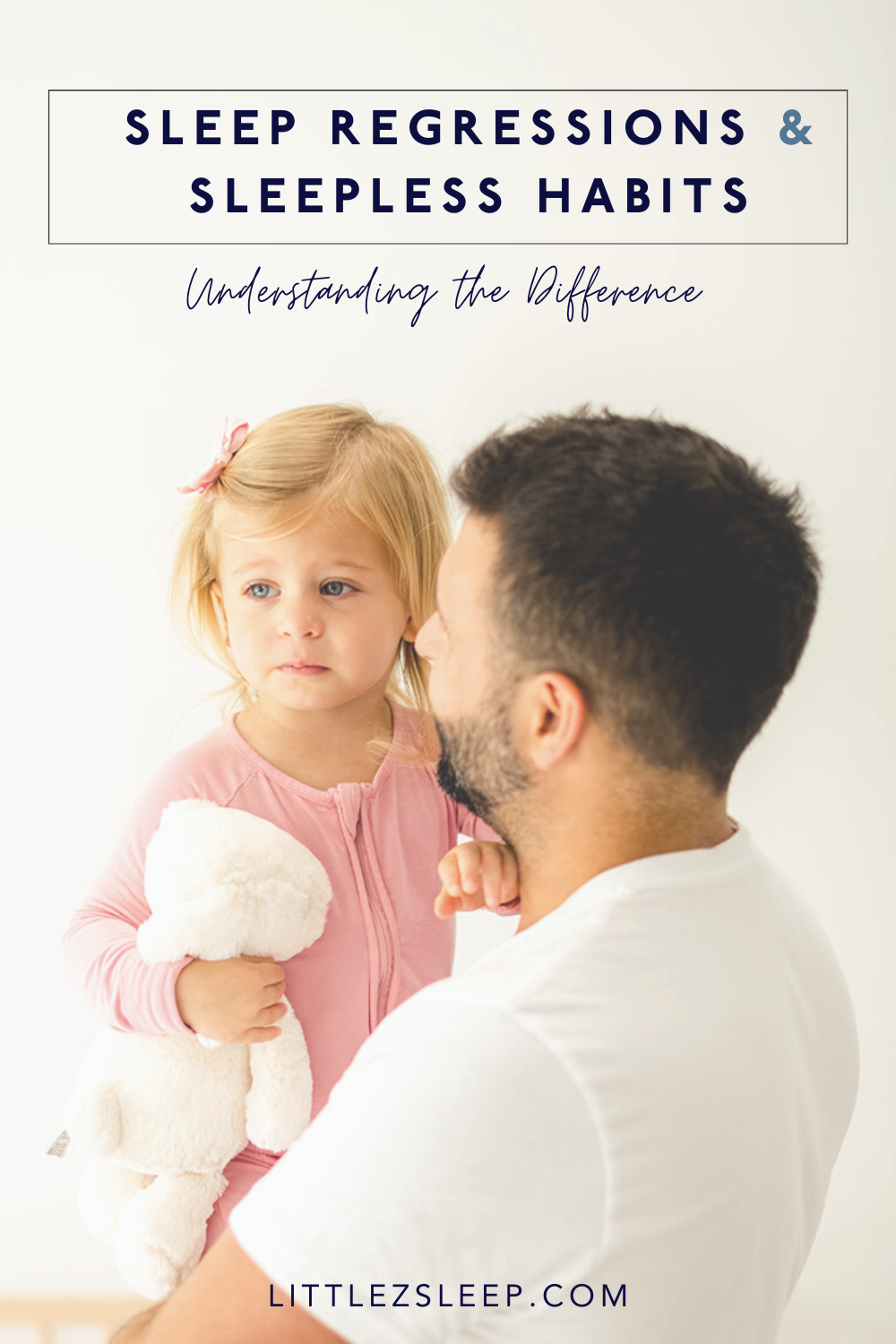Is It A Sleep Regression or a New Habit?
What if I told you there is a simple way to identify whether your child is experiencing a developmental sleep regression or a new, sleepless habit?
In this video and podcast I am going to teach you exactly what you need to know when it comes to understanding the difference between sleep regressions and new habits and how to handle them.
What is a Sleep Regression?
So what exactly is the difference between a sleep regression and a new habit?
Since true sleep regressions do not occur during the newborn stage, the following information is designed for children 4 months of age and older.
First off, let’s define what a sleep regression is.
A sleep progression is when your child was previously sleeping soundly and consistently and all of a sudden their sleep is greatly disrupted and unpredictable.
Simply put – a sleep regression is the sudden change in your child’s sleeping patterns.
Your previously good sleeper is now all of a sudden riding the struggle bus when it comes to sleeping and you’re left scratching your head.
When a regression occurs in your child’s sleeping pattern and this change in their sleeping pattern becomes their “new normal,” then it’s considered a new habit.
A sleep regression is NOT dependent on a specific age.
Yes, there are common themes when it comes to regression ages like the 4 month, 8 month, 12 month, and 18 month regressions.
However, a sleep regression can happen at any age because your baby or toddler is rapidly growing and developing.
A sleep regression can be triggered by learning new skills like rolling, crawling, pulling to stand, standing up, jumping, running, talking, eating solids, potty training, etc.
This is because when we are sleeping (even as adults) our brain is processing everything that we did and learned that day!
For example, it’s very common for a 2-2.5 year old who is blooming and bursting with new words to wake up in the middle of the night and start singing, babbling, or talking!
One time I was sent a video of a little toddler who woke up in the middle of the night and started singing a Christmas song! She sat up in her crib, sang the song, and then laid back down and went to sleep.
She had just learned the song and her brain was processing the new melody and vocabulary. How cool is that?
It’s so amazing to see what our children are processing and learning, but if it’s disrupting their sleep then we want to make sure it doesn’t become a learned habit.
So I know you’re wondering, “How do we know if it’s a regression or a new habit, Becca?”
It’s simple.
Examine the timeline:
- If the new sleeping behavior or pattern has occurred for 2 weeks or LESS, then it’s likely a sleep regression.
- If the new behavior or pattern has occurred for 2 weeks or LONGER, then it’s likely a new habit.
For example, if you’ve been experiencing the “4 month” sleep regression and your child is now 6 months old, then your child is no longer experiencing the 4 month sleep regression but instead has developed a new, sleepless habit that has become the “new normal.”
How to Handle A Sleep Regression
Okay, now that you’ve identified whether or not your child is experiencing a sleep regression or has developed a new habit, it’s time to dig in to some strategies in order to help them overcome this disrupted season of sleep!
First let’s dive into how to handle a sleep regression.
#1 Ensure your child is following an age appropriate schedule
if your child’s sleep patterns have been off for 1-2 weeks, then the #1 thing you can do is check and ensure that your child is following an age appropriate schedule.
Oftentimes, when someone is experiencing a sleep regression with their child, it’s because their child isn’t on the correct nap schedule!
If you aren’t sure whether your child’s schedule is age appropriate or not, I want you to go to my FREE Schedule Generator HERE and check.
Simply type in your child’s current age and you will receive their age appropriate schedule.
Once you know that your child is following the correct schedule, it’s extremely important that you are consistent with honoring it.
Sometimes, it’s tempting to want to tweak your child’s schedule every day or every other nap when they aren’t sleeping “perfectly,” but I’m asking you to be extremely consistent with their schedule for at least 2 weeks before making any other changes.
Consistency is the name of the game when it comes to working on sleep because unfortunately, it’s not an overnight success story.
It will likely take a few days and nights for you to see things go back to normal if your little one is experiencing a regression.
#2 Evaluate your child’s sleep environment for distractions
The second thing I want you to do if your child is experiencing a regression is to check your child’s room.
Oftentimes, a regression is linked to an environmental distraction.
Maybe the blackout covers have slipped down and light is coming in, or maybe the sound machine isn’t working properly or perhaps it’s too hot or too cold in your child’s room.
Assess your child’s bedroom environment and ensure that it’s distraction free.
I’ve had a few instances where families have reached out and told me about their child’s sleep regression and after they’ve done some digging they’ve found that their child was waking due to an environmental factor such as the sound of the air conditioner kicking on or the noise from their neighbor’s car starting early in the morning!
Once you’ve checked your child’s daily schedule and have ensured that their sleeping environment is distraction free, then your child’s sleeping regression should likely subside within a few days if you remain consistent with their schedule and sleep expectations.
How to Correct a New Habit
If your child has been riding the struggle bus with sleep for more than 2 weeks, it’s official that they have developed a new habit that needs to be corrected.
Thankfully, we know exactly how to help you and your little one sleep independently again.
If your child has developed a new, sleepless habit then it can be remedied and corrected with sleep training.
Sadly, sleep training is oftentimes seen as a “taboo” word in the parenting world and it’s completely misunderstood.
However, sleeping and being well rested is NOT some elusive unicorn dream that you just can’t have as a parent.
Being well rested is COMPLETELY possible as a parent and if you are a parent who is totally exhausted, then I want to point you to my sleep programs HERE, where you and your whole family can make sleep a thing – together!
Our sleep training programs here at Little Z’s are priceless tools because they can act as a “refresher” any time you need to go back to the basics and “retrain” your child.
And it’s safe to say that everyone needs a refresher once in a while when it comes to sleeping expectations, including adults.
Think about it.
If you’ve ever gone on a vacation or experienced a season during work where you had to stay up really late or get up really early in the morning, you’ve had to function off of a significant sleep deficit.
When you were finally able to get back on track with a more consistent, sustainable sleeping routine, it’s undeniable that you felt s0 much better.
The same thing is true for your child.
If they have spent weeks getting off track with their sleep, or following the wrong schedule, then it’s time to reset them and refresh the sleeping expectations.
The great news is that if you have already purchased one of our sleep courses, you can simply log back in to your account and complete the course from Night 1.
That’s because when you purchase one of our sleep courses, you have lifetime access to it.
If you haven’t purchased one of our courses before, then I want to just take a moment to pause and share about the four sleep training methods.
The four sleep training methods are 1) Cry-It-Out (CIO), 2) Leave and Check, 3) Stay in the Room, and 4) Pick-Up-Put-Down.
<<< If you are unfamiliar with the sleep training methods above be sure to check out my blog and video explaining the four sleep training methods HERE.>>>
When it comes to choosing a sleep training method for your child and your family, it’s important to pick a method that matches your parenting philosophy.
By identifying your parenting philosophy and sleep goals, you will be able to commit wholeheartedly to the method you and your family choose to follow.
Here at Little Z’s, we personally use the middle two strategies, the Leave and Check Method and the Stay in the Room Method.
You can find the other two methods, the Cry It Out Method and the Pick Up Put Down Method, represented in other sleep philosophies.
Once you’ve picked your method, whether you are retraining or training for the first time, your commitment and fidelity to the method and program will be vital to your training or re-training progress and success.
And at the end of the day, it’s important to remember that you can’t force your child to close their eyes and fall asleep – they have to do that!
However, you can make the sleep training process less cumbersome and more enjoyable for everyone involved by providing your child with a clear plan, consistent expectations, and a loads of encouragement!
Conclusion
Be encouraged that if your child is experiencing a sleep regression or has developed a new, sleepless habit, things are not hopeless!
You can support your child through this period of disrupted sleep by:
- Evaluating the timeline of your child’s sleep disruption and determining if its a regression (1-2 weeks) or a new habit (2+ weeks or longer).
- Ensuring their schedule is age appropriate (and following it consistently!)
- Assessing their sleeping environment and ensuring that it’s distraction free.
- Considering their current developmental stage to determine whether this period of disruption has been caused by newly learned skills and milestones.
If your child has developed a new habit you can help them make sleep a thing again by 1) retraining them or 2) sleep training them for the first time!
If you’re ready to sleep train your baby, toddler, or preschooler, be sure to check out or baby sleep programs HERE so that we can help you and your family make sleep a thing as soon as possible.
LOVE IT? PIN IT FOR LATER!





